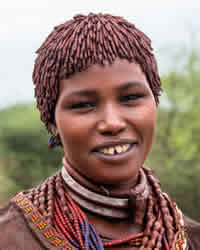The Hamer live in the highlands of southwest Ethiopia. They are primarily located in the Gemu Gofa province, which is east of the Omo River and north of Lake Turkana. This area, called the Lower Omo region, has remained one of the most inaccessible and least developed parts of East Africa.
The Hamer consist of two separate ethnic groups, the Hamer and the Banna, who speak virtually the same language. Though they refer to themselves as either Hamer or Banna, they call their language Hamer-Banna. They belong to a group of culturally distinct people known as the Sidamo. Although they are racially mixed with the Bushman hunters who originally inhabited the region, they do not have Bushman features.
The Hamer live in camps that consist of several related families. The families live in tents arranged in a circle, and the cattle are brought into the center of the camp at night. When the campsite is being set up, beds for the women and young children are built first; then the tent frame is built around it. The tents are constructed with flexible poles set in the ground in a circular pattern. The poles are bent upward, joining at the top, and then tied. The structures are covered with thatch during the dry season and canvas mats during the rainy season. Men and older boys usually sleep on cots in the center of the camp, near the cattle.
Livestock belonging to the Hamer consist mainly of cattle, although there are some sheep and goats. Camels are used for riding and as pack animals. Most Hamer plant fields of sorghum at the beginning of the rainy season before leaving on their annual nomadic journey. Some households also plant sesame and beans. Because the crops are usually left unattended, the yields are low. Few households grow enough grain to last through the year.
One striking characteristic of the Hamer-Banna men is that they indulge in elaborate hair-dressing. They wear a clay "cap" that is painted and decorated with feathers and other ornaments. Much time is spent in preparing the hair, and care must be taken to protect it from damage. This is one reason the men often sleep on small, cushioned stools. A well-dressed man will wear a toga-like cloth and carry a spear and a stool. Women also commonly wear colorful toga-like garments.
Boys are initiated into manhood through a ceremony where they must run across the backs of a row of steers or bulls. Before the ceremony, their female relatives invite being whipped by men to show their solidarity with the initiate. Women who can endure more pain are considered better marriage prospects because she is prepared for child birth.
Men may marry as many women as they like, but only within their own tribe. A "bride price" of cattle and other goods is provided by the prospective husband and his near relatives. A typical household consists of a woman, her children, and a male protector. A man may be the protector of more than one household, depending on the number of wives he has. Also, men are sometimes assigned the responsibility of protecting a divorced woman, a widow, or the wife of an absent husband (usually his brother). Marriage celebrations include feasting and dancing.
The Hamer are mainly adherents of traditional religions. For instance, they believe that natural objects (rocks, trees, etc.) have spirits. They also believe in jinnis, or spirits that are capable of assuming human or animal form and exercising supernatural influence over people.
The New Testament is available in the Hamer-Banna language in both print and audio, and the JESUS Film is available. They once had workers from SIM International; more laborers and evangelistic tools are needed.
Pray for God to grant his favor and wisdom to any mission agencies that are currently focusing on the Hamer-Banna.
Ask the Lord to call additional long-term workers to live and work among the Hamer.
Pray there will soon come a day when Hamar disciples will be making more disciples.
Pray for a hunger for true spirituality among Hamar elders and family leaders.
Scripture Prayers for the Hamar in Ethiopia.
https://en.wikipedia.org/wiki/Hamar_people
https://www.bing.com/videos/riverview/relatedvideo?&q=hamar+ethiopia&&mid=C0D059965785BDE12B8FC0D059965785BDE12B8F&&FORM=VRDGAR
| Profile Source: Joshua Project |

























